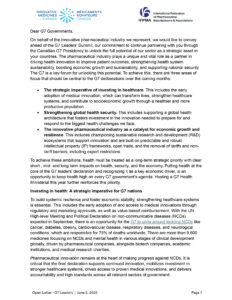
Pharma 101
A beginner’s guide to the research-based pharmaceutical industry
It takes more than a decade and $2.6 billion in R&D spending to create a research-based medicine.
The process begins in preclinical research, where pharmaceutical researchers isolate 5,000 to 10,000 compounds for potential new medicines, selecting about 250 to test in the next phase. This process can take three to six years. In the second phase, researchers further narrow their selection for an in-depth clinical investigation. After the investigation is complete, clinical trials can begin. The entire process of completing all three phases of research takes thousands of volunteers, scientists, doctors, and researchers.
Phase 1
Preclinical Research
Researchers isolate 5,000 to 10,000 compounds for potential new medicines
Phase 2
Clinical Investigation
Now at about 250 compounds, researchers further narrow their selection for an in-depth investigation.
Phase 3
Clinical Trials
After the investigation is complete, clinical trials can begin.
The road from drug discovery to your medicine cabinet is fascinating. It’s also long, complex, and costly – with no guarantee of success. When clinical trials don’t show promise for a new drug, researchers go back to the drawing board. When a new medicine is successful, it can face two years of regulatory approvals before it is finally delivered to patients.
Innovative Medicines Canada works on behalf of Canada’s life sciences sector to propel innovation, protect patient safety and get medicines into the hands of Canadians.
Specialty medicines are revolutionizing healthcare
Personalized medicine is fundamentally changing healthcare by offering enormous benefits to patients. Healthcare practitioners are now able to choose medicines that target illnesses or diseases based on a patient’s genetic predisposition to an illness.
Personalized medicine is fundamentally changing healthcare by offering enormous benefits to patients. Healthcare practitioners are now able to choose medicines that target illnesses or diseases based on a patient’s genetic predisposition to an illness.
Biologics are complex and highly sensitive medicines grown in labs from living cells such as blood, proteins and viruses. They differ hugely from conventional pharmaceuticals, like aspirin, which are chemically synthesized in an orderly, predictable process.
Biologics cover a wide variety of products, including vaccines, tissues, gene therapy and stem cells. Some biologics are well known. Botox is a biologic. So is the popular drug Humira, which is used to treat arthritis and other conditions.
While complex to produce and store, biologic medicines have dramatically improved the lives of patients, who often experience better health outcomes and fewer side effects than when they are treated with conventional pharmaceuticals. Some biologics are being used to treat conditions that had no treatments just a few years ago.
Biologics benefit not only patients and their caregivers, but also the healthcare system as a whole by reducing costs, reducing complications and improving the productivity of healthcare employees. These innovative medicines improve society’s standard of living and health, as well as help Canada meet its innovation goals.
The advent of genomics technology has revolutionized the field of biologics. We can now identify genetic causes or dispositions to disease and manufacture almost any type of DNA, proteins, antibodies or hormones.
Biosimilars are the pharmaceutical industry’s answer to producing an imitation biologic once the innovator’s patent has expired.
Biosimilars cannot be called “generic” versions of a biologic because they are too complex to be exact copies of the original. No two biologics can exactly match, which means they can never be precisely interchangeable the way conventional pharmaceutical generic drugs are.
Here is how Health Canada describes biosimilars: “A biosimilar is a biologic drug that is highly similar to a biologic drug that was already authorized for sale.” Biosimilars represent a legal or regulatory construct rather than a class of therapeutics.
Many healthcare companies are now producing biosimilars. As long as patient safety and an innovator’s intellectual property are protected, biosimilars can be used to provide choice for healthcare professionals and patients. They also allow for additional savings to both public and private payers, which can be reinvesting in new innovative therapies coming to the market.
Because biosimilars cannot be shown as interchangeable to the original biologic, they need to be tested and regulated just as rigorously as the original.
How Canadians access medicines
Most Canadians receive pharmaceutical coverage either through government-funded plans or through private health insurance coverage provided by their employer. Approximately 25 million rely on private plans for coverage. Others rely on provincial and territorial plans and a few pay directly out-of-pocket for prescription medicines.
A recent study compared Canada to 19 other countries on how well people are covered financially for new medicines under public drug plans. Canada fared poorly on all the study’s parameters – 15th out of 20, at best.
It is important to develop a system that leads to open, rapid access to medicines, and that allows physicians to prescribe the most effective treatment plans possible. Innovative Medicines Canada is working with governments and industry to facilitate a more equitable system for all Canadians.

Public plans are paid for and administered by provincial and territorial governments. Most plans cover medicines and vaccines for eligible groups, including seniors, recipients of social assistance and individuals with conditions that are associated with high drug costs. Many public plans also have programs to cover the costs of certain types of medicines or to cover individuals with particular health conditions like diabetes or cancer, for example. Public plans also cover medicines administered in hospitals.
Insurance companies create benefit plans that employers can use to support the health and wellness of their employees. By paying for plans that cover innovative medicines and vaccines, employers are able to sustain a healthy and productive workplace, retain quality employees, improve morale and demonstrate social responsibility.
The Patented Medicines Prices Review Board sets the maximum allowable prices of all patented medicines in canada. The PMPRB sets the price ceiling based on:
- an assessment of the therapeutic value a product brings
- the price of existing, marketed products
- prices for these products in other countries
After the PMPRB sets the acceptable limit, public health plans and private insurers can negotiate with manufacturers on the cost. For public plans this is conducted via the pan-Canadian Pharmaceutical Alliance (pCPA).
Before covering a medicine or vaccine, public plans also assess the value of the product. This assessment is undertaken by the Canadian Agency for Drugs and Technologies in Health (CADTH) and sometimes also by their own organizations within the province or territory.
Provincial and territorial governments face significant pressure when establishing health budgets and policy. Provinces and territories negotiate product listing agreements with pharmaceutical companies to provide patients access to innovative medicines. Canada’s innovative pharmaceutical companies have a crucial role to play in helping governments achieve their healthcare goals.
Patient safety is our top priority
All new medicines go through multiple and exhaustive levels of review, thorough clinical testing and ongoing monitoring after they reach the market. Canada has a strong and robust regulatory protocol to ensure Canadians have safe and effective medicines. Of course, it’s necessary to take them as prescribed by healthcare professionals.

We work with all our partners in healthcare to provide Canadians with the information they need to safely and effectively take their prescription and over-the-counter medicines.



